#12 NW Front Street
Coupeville, Washington
Blowers & Kineth Cash Store / Coupeville Pharmacy / Sea Bre's Yarn Shop / Salty Vons Waterfront Inn.
1886 - Building was built by J.J. Staub (a blacksmith) on a lot leased to him by John Robertson. It was called the Coupeville Cash Store.
1889 - Kineth & Blower leased the store and continued to operated it as the Coupeville Cash Store.
1899 - Blowers sold his interest to Scott Wiggens and named it the Kineth & Wiggins.
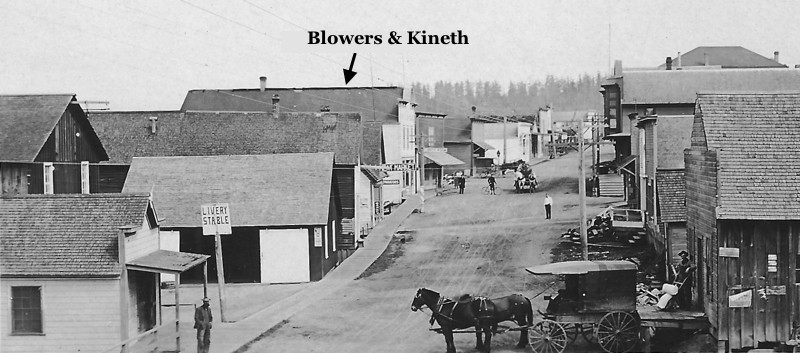
Kineth and Blower in the 1890s
Courtesy: Island County Historical Museum, Coupeville
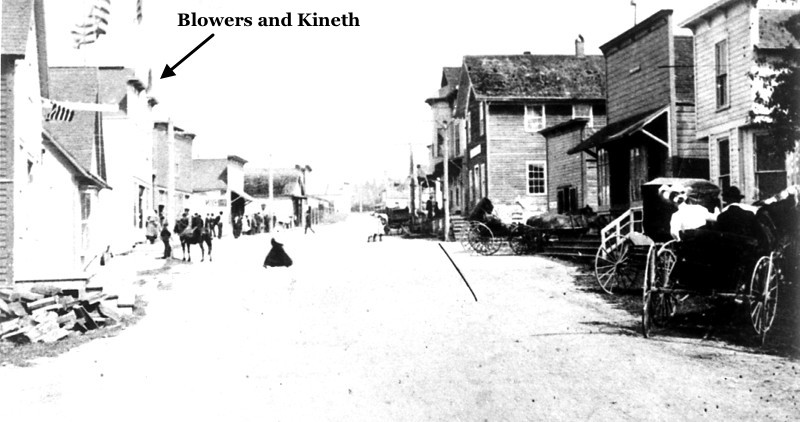
Kineth and Blower in the 1890s
Courtesy: Ebey's Landing National Historical Preserve
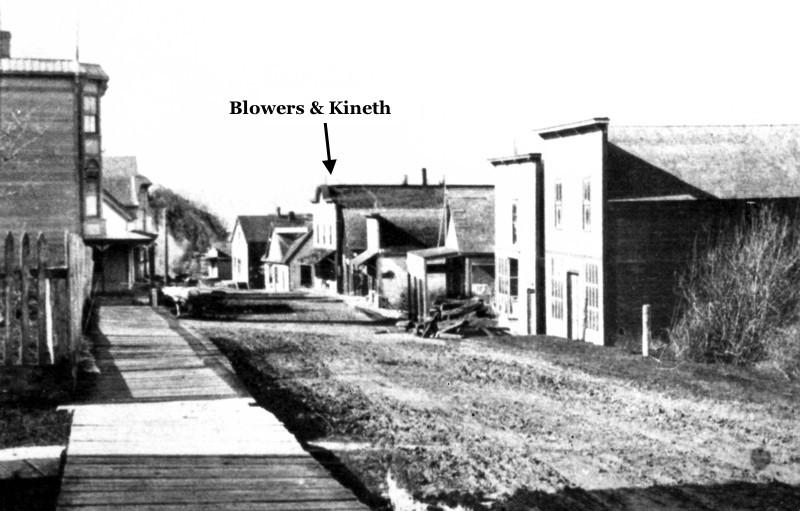
Kineth and Blower in the 1890s
Courtesy: Island County Historical Museum, Coupeville
Quote from "A Particular Friend - PENN'S COVE" by Jimmie Jean Cook. 1973
BLOWERS & KINETH
On March 19, 1886, John Robertson entered into a lease agreement with blacksmith J. J. Straub which allowed Straub to build a good and strong building 30' x 40' within two months time, to be situated directly west of the Robertson store. The terms were rent at 50¢ a month payable at the end of the month. If Straub did not wish to buy the building at the end of the lease, a suitable price would be given by Robertson. It was agreed that Straub could use the lower part of the building as a wagon shop.
In 1889 the building was leased to Blowers & Kineth for three years, inasmuch as Straub had built another shop nearer his home. The merchants were not to be charged in excess of $25 per ton for freight, merchandise and produce received or shipped over Robertson's wharf for the next two years.
In 1892 these two partners, operating under the name Coupeville Cash Store, had advertised binders, mowing machines, wagons, pulverizers, hay racks and were dealers in dry goods, boots and shoes, groceries, hardware and crockery.
In 1890 the San de Fucan reported that Blowers & Kineth had the most extensive general store in Coupeville. They were sending a wagon to San de Fuca to
pick up butter and eggs and to deliver groceries to the residents there. In 1899 Blowers sold out his interest to Scott Wiggens and the firm was then called Kineth and Wiggens. It was in operation until a grocery under sold to Nels Sill. It still continued as later management by Ralph Lindsay.
In 1952 Harry Hurd bought the building and it was known as the Coupeville Pharmacy. It was then sold to Ted Christensen who moved the drug store to the new shopping center and in 1959, the building was sold to the present owner and became an antique shop.
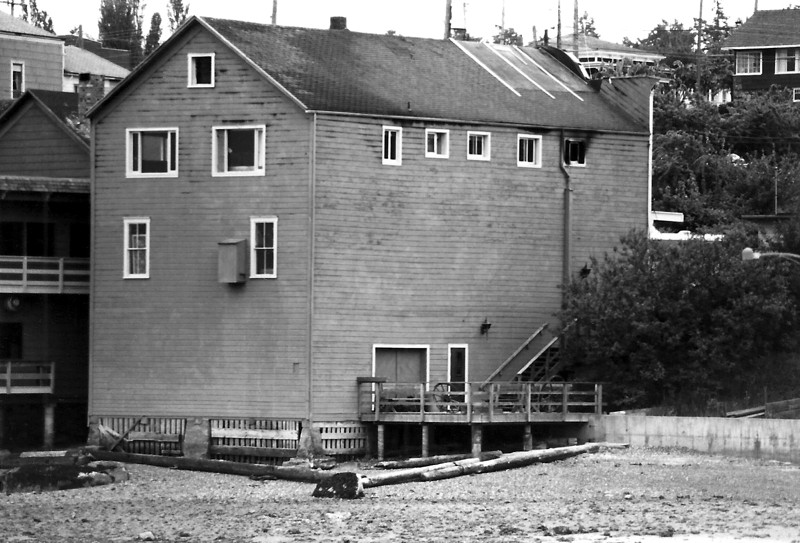
The building from the beach. Note the wagon wheels at the lower level.
Courtesy: Island County Historical Museum, Coupeville
1925 - The building was called the Sills General Merchandise and was run by L.N. (Nels) Sill. A staircase up the center to a mezzanine was built. Fresh produce and general merchandise was sold.
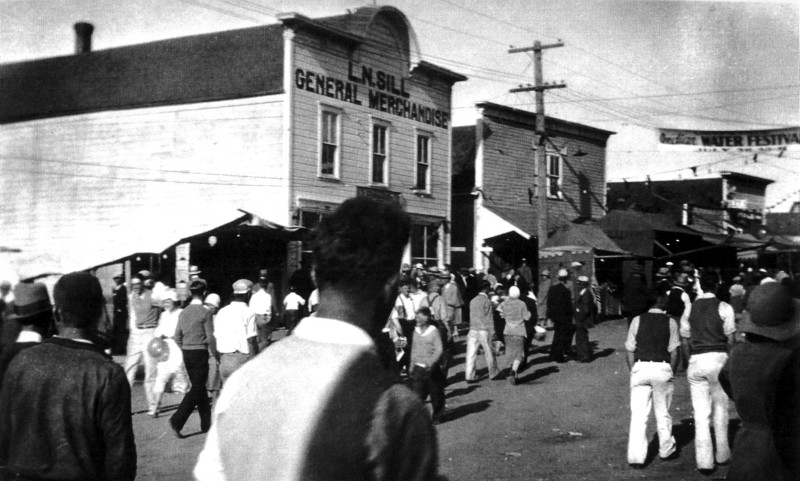
Sill's Grocery in the 1930s
Courtesy: Island County Historical Museum, Coupeville
*Interview by Judy Lynn with Nancy Hurd Napier, 2010
So my folks came to Coupeville. The pharmacy representative knew about the building on Front Street (Coupeville Cash Store) that was vacant. I remember going in the first time to see it. There was a magnificent set of stairs up the center to a mezzanine. It went left and right around the perimeter of the building. And there was a creepy basement with a giant boiler for the furnace that had to be heated by wood. My brother and I were excited about being able to play on the beach. They decided to buy the building
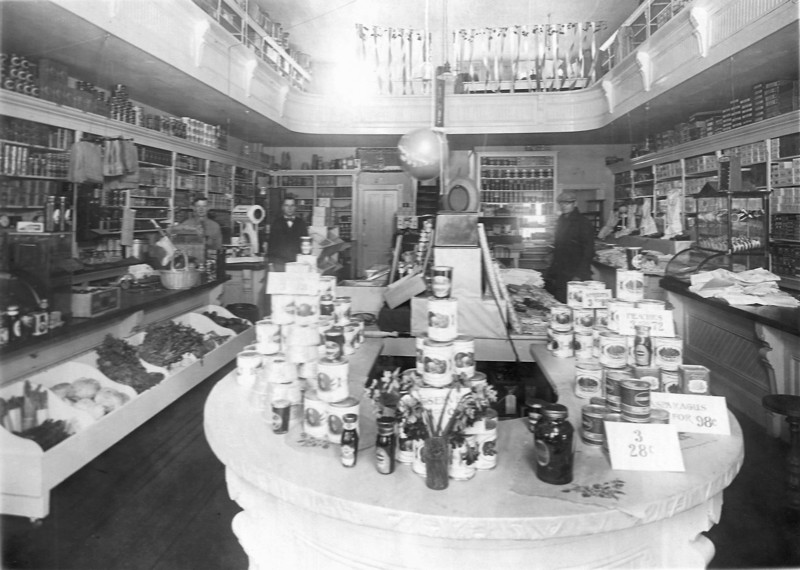
Sill's Grocery in 1925
Courtesy: Island County Historical Museum, Coupeville
*Interview by Judy Lynn with Nancy Cecilia Holt, 2012
I remember Nells Sills but I didn't know him too much. He had a grocery store (Kineth and Blowers building) He had clothes there too. We had to visit with all these guys. We went in for groceries at his store but we didn't go as much but some. In the next building was Capaan and Parker meat market. Once in awhile when I was with mother he would give me a hotdog.
1930's During Water Festivals, bleachers were set up on the back of the building for spectators
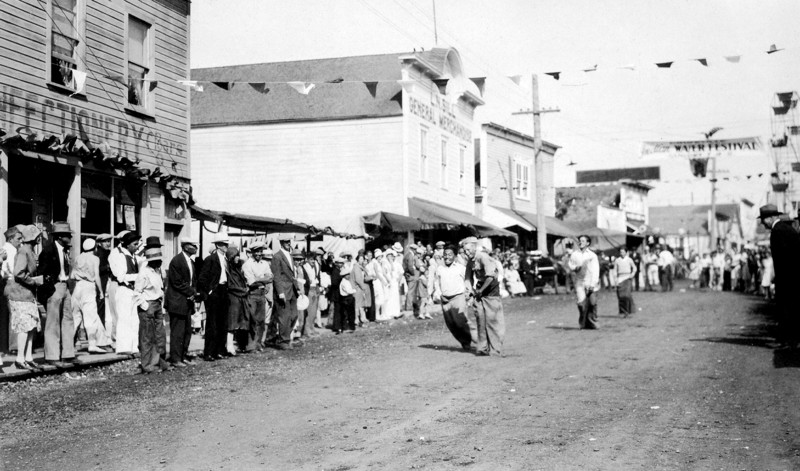
Sill's Grocery during a sack race in a Water Festival.
Courtesy: Island County Historical Museum, Coupeville
1944 - Mr. Moore sold the grocery store to Ralph and Lottie Lindsay. Warren Lindsay worked for Mr. Moore early 1940s.
1947 - Lindsay's moved the grocery to Mariner's Court. Sold building to Harry Hurd to be drug store.
1952 - The building became the Coupeville Pharmacy owned by Harry Hurd. It had a soda fountain. Harry lived the floor above.
*Interview by Judy Lynn with Diane and Roger Eelkema, 20092
Roger: The next building was Hurd's drug store. Their son Rusty was my age. I would go down town to the soda fountain. They had apartments above in that building - about 1955 to 1960. I'm not sure that street was paved yet - maybe graveled. They did pour oil and water on it to keep the dust down.
*Interview by Judy Lynn with Paul Whelan, 2008
In Millie Fonda's building [Blowers and Kineth] there was a soda fountain on the right side when you went in. I remember when the drug store moved up to North Main - in the 50's sometime. Muriel Harris worked at Christensen's drug store.
*Interview by Judy Lynn with Malcolm Bishop, 2007
Malcolm: Sometimes when we were at the office for a long time we'd get to go to Hurd's Drug Store across the street and get a milkshake or soda. On the right was the soda fountain and I remember the milk shake machine. There was a lot of merchandise too. He had models of cars and planes that I liked looking at. I never paid for anything I got there. I'm sure it was written down in an account.
*Interview by Judy Lynn with Nancy Hurd Napier, 2010
Nancy: We came to Oak Harbor in 1947. My dad, Harry Hurd, was a pharmacist and had a pharmacy on Capitol Hill in Seattle. Tom Nash, who owned Oak Harbor Pharmacy on Pioneer Way asked him to come to Oak Harbor to work for him. He worked for Tom for 4 years.
Judy: What was your mother's name, and dates of birth and death of your parents?
Nancy: My mother's name Alberta Christy Hurd but she went by Bert. She was born December 14, 1917 and died August 15, 2001. My dad, Harry W. Hurd, was born March 8, 1890 and died January 16, 1969.
Judy: How did you dad happen to open the pharmacy on Front Street in Coupeville?
Nancy: The McKessen and Robbins representative to the pharmacy told my dad about a Shelton pharmacy that was going out of business. At the time there were only two pharmacies on Whidbey, Leo Lee's in Langley and the one in Oak Harbor. They both delivered on the Island. The representative convinced my father that Coupeville needed a pharmacy. This was before there was a hospital. There was just Dr. Bishop and Polly Harpole in Coupeville.
My parents drove to Shelton to see about buying out the pharmacy lock, stock, and barrel, which they did. They bought the pharmacy supplies, display cases and soda fountain.
We lived at the time in Scenic Heights and I was in the fifth grade. They had to find a place to put the pharmacy and a new place to live. Nobody knew that my dad was going to do this, not even Tom Nash. One day some people knocked on the door on Scenic Heights. The house was not on the market but these people wanted to see the house and then said, "We'd like to buy your house. What would you take for it?" My folks couldn't believe it. They explained that they were thinking about selling the house but hadn't told anyone.
So my folks came to Coupeville. The pharmacy representative knew about the building on Front Street (Coupeville Cash Store) that was vacant. I remember going in the first time to see it. There was a magnificent set of stairs up the center to a mezzanine. It went left and right around the perimeter of the building. And there was a creepy basement with a giant boiler for the furnace that had to be heated by wood. My brother and I were excited about being able to play on the beach. They decided to buy the building.
Judy: Who did they buy it from?
Nancy: I can't remember.
Then the folks had to look around for a place to live. I remember the sign at the edge of town stated there were 250 people in Coupeville. There was only one house available to rent at the time - the Harry Stark house on 9th street on the left.
Around the time we moved I remember watching on a little TV Eisenhower's inauguration, the crowning of Queen Elizabeth and the Nevada Flat tests. We lived there while they moved in the pharmacy.
I don't know who the carpenter was, but my dad had a second story living space created. The floor was the level of the previous mezzanine. Our place was on the waterside and consisted of three bedrooms, a bath, kitchen and living area. They put a studio apartment upstairs above on the street side. There was a big long closet that could be bolted from both sides that served as a pass through to both sides. (Note: the door between the studio and front apartment is still there in but no longer goes through to the front apartment.)
The studio apartment was furnished with my grandmother's furniture. Her name was Florence Hurd and she lived in Bellingham before she passed away. There was a bed, dresser and a chest of drawers. Much later when I came back to Coupeville, I went into the building when it was an antique store. I spied the bed for sale in the back. I asked the price and was told it was not for sale. I was told it had been brought from back east but I pointed out evidence of the footboard being made from the headboard that I remembered as a child. (Note: Millie Fonda speculates the person who disputed the bed was Ken Kroll because he brought antiques from back east.)
Judy: What was your brother's name?
Nancy: His name is Harry Burton Hurd (born December 20, 1947) but he always went by Rusty. He lives in Deming. He is five years younger than me.
My brother and I spent hours playing in the basement. When I went later to the restaurant they opened down there it looked so small. I said to the owner, "I can't believe it was the same basement. I used to live here. It was sure bigger." She asked me if I had a key to the safe. I don't.
That safe came out of the Shelton Pharmacy. (Note: The safe currently in the lower level of the Coupeville Cash Store has the names "Blower and Kineth and Anacortes Safe" on it, so wouldn't be one from the Shelton Pharmacy.) Daddy also had a big cash register that had a lot of drawers from the Shelton store. I asked them if it was still there but was told "No."
The furnace was where the wine room was (in Ken Kroll's ownership). [Note: Millie Fonda states the furnace was on the cement pad where the safe now sits. Millie has the combination to the safe and it still works.] We rode our bikes and trikes down there. There was a big grate upstairs where the heat rose and everyone warmed their feet by standing on it. We had crosshatched marks on our shoes.
My brother and I went everywhere on our bikes, even Fort Casey. My Mother was asked by her friends, "Weren't you worried?" She wasn't. It's not like today. Anyone that came into the pharmacy told the folks they knew where we were.
Judy: When did they buy the building?
Nancy: They bought it in 1950 or 1951. [Note: in A Particular Friend, Penn's Cove, page 96, "In 1952 Harry Hurd bought the building and it was known as the Coupeville Pharmacy.] It was nearly a hundred years old then. [Note: The building was built in 1886.] There wasn't a nail that put it together - it was all wooden pegs. The furnishings from the Sheldon pharmacy included beautiful mahogany cases with curved glass tops and shelves. The fountain sat 8 to 10 people. There was a very long mirror on the back wall. How they got it on the ferry I don't know. All the townspeople came to have coffee, milk shakes, sodas, and sundaes. The folks didn't serve food. [Note: Millie Fonda thinks the cases in the back of Back to the Island were the pharmacy cases, but they are not mahogany.[
Judy: What was the name of the pharmacy?
Nancy: Coupeville Pharmacy.
There was an enormous roll-top desk that was too big for upstairs that they put in the basement. It was so big my brother and I were able to hide in it.
Judy: How did you get into the basement?
Nancy: The basement did have a sliding door (barn door) out to the deck on the west side of the building. There was a metal lined wood slide that went from the street to the deck. It's where they slid the wood down to store for the wood heater. We pitched the wood into downstairs.
There were comic books in the drug store. They let kids sit on the floor heater and read comic books if they promised to take care of them and return them to the racks. My brother and I had the best comic book collection. My dad would get credit from the comic distributor if he returned the covers so we had lots of comic books without covers.
Judy: Was there just one floor heater?
Nancy: Yes. Daddy would get up early to build a big fire. They were early risers so were probably up by 6:00 am. He would start the fire to warm the store and then make the coffee for the "bar flies."
Judy: What did they do with the original staircase?
Nancy: They didn't take it out. Dad had doors built in front of the treads but that he could open. The stairs were not visible, as there were walls on either side of the stairs. He used the stairs as storage place. He kept big brown jugs of ammonia and other things he used to make the drugs. In those days he made all the prescriptions and filled capsules. I remember once finding my blue bike that was supposed to be from Santa they had hidden on the stairs.
There was a room on the left (northwest) side with stairways that went both up to our apartment and down to the basement. [Note: Millie Fonda said, "There is evidence of the stairs that went up to the upper level in the storage area in the middle of Back to the Island. On the right I think the lower level was reached by lifting up a hatch door".]
In the back on the right (northeast) of side of the store is a little room where my dad and his cronies, (Alden Whalen, Judge Joe Kramer and a fellow with the last name Withrow), would met once a week and play poker. He had a "want-ad book" in which he kept track of who had the highest score. No money was involved. He ended up with stacks of those books. In order to keep the light from shining out on the street so people wouldn't think the pharmacy was open, he hung an Army blanket over the doorway of the little room. They called the group the Blanket Club.
There was a big heavy, thick door that went down into the basement. Wharf rats chewed a hole in it to get into the pharmacy. One day when dad was fishing, mom was running the store. She was behind the fountain and the state inspector was there, inspecting the wash and rinse water. Mother spied a big beach rat that ran just under the fountain. She didn't scream because of the inspector but it scared her half to death. It was the only one she saw. They sat out rat-traps after that, but the rats were bigger than the traps.
Upstairs in our apartment were windows that opened on the waterside. My brother and I spent 90% of our time out at the dock. Mr. Hanson had the granary and we got to help him. We fished a lot. When it was time to eat, mother would open the window and yell at us to come home.
Judy: How long did it take your dad to set up the pharmacy?
Nancy: Six months or so. I was in the fifth grade first in Oak Harbor and then Coupeville.
Judy: Did the pharmacy open about the same time you moved into the apartment above it?
Nancy: Yes, at the same time.
Judy: What can you tell me about the opening?
Nancy: People signed up for drawings of things my dad gave away. In those days, Cody cosmetics were beautiful. In the first showcase when you walked in were Cody cosmetic products. They were beautiful. The dusting powder containers were music boxes. The case held beautiful gifts. You had to ask for help in order to hold them as they were under glass.
Judy: Tell me more about the layout of things in the store.
Nancy: The fountain was on the right (east) side. There were stools and the colors were green, blue and cream. The bar top was smooth but I don't remember what it was made of. On the left (west) side wall were shelves that held sundries, shampoos and other things. There were other showcases that held things for sale. On the far end of the counter was a cold case with ice cream bars. I remember if my hands were wet and I touched the case my hands would stick.
Dorothy Neil used to come in two or three times a week, sit at the end and collect information for her newspaper column. Dr Bishop, Alden Whalen, and Joe Libbey would come every morning to have coffee. In those days people didn't park parallel to the sidewalk, but nosed in toward the building.
1959 - Ted Christenson bought and moved the drug store to the new Main Street shopping center. He sold the building to Ken Kroll
1970 - The Butler's Bell antique Store was opened and managed by Charlene Scoby.
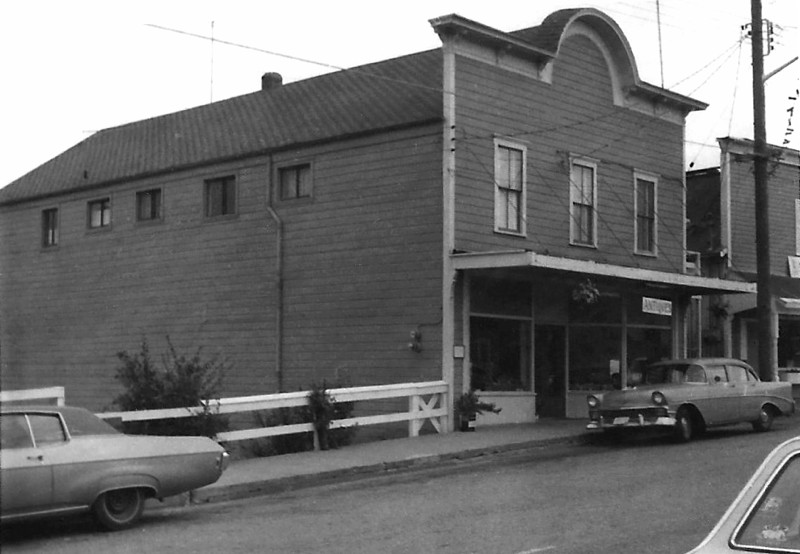
Antiques Store
Courtesy: Island County Historical Museum, Coupeville
1970s - A wine cellar & tasting room was added in basement, excavated under wall, laid oak plank floors, added a new roof, replaced wiring and plumbing. There was also a candle store in the basement at this time.
*Interview by Judy Lynn with Bill and Jan Skubi, 2010.
Bill: Bill Barry and I plumbed the palatial bathroom down there in the lower level. We installed the hot tub, double shower and double sink and toilet all with gold-plated fixtures. (Bill Berry was somewhat incapacitated and I had to do a lot of the work for him.) I knew Ken Kroll. Jan and I knew him from the Captain Whidbey. In fact John Stone, at the behest of Ken Kroll, had an extensive collection of wines at the Captain Whidbey.
1980s - Al and Kathy Griggs operated the Great Times Espresso on the lower floor until 1991
1982 - There was fire in upper floor that burned through the roof. The building unoccupied until 1983.
1983 - Ken Kroll and George Lloyd became partners in Salmagundi (antiques) until 1992 - They performed renovations to the apartment.
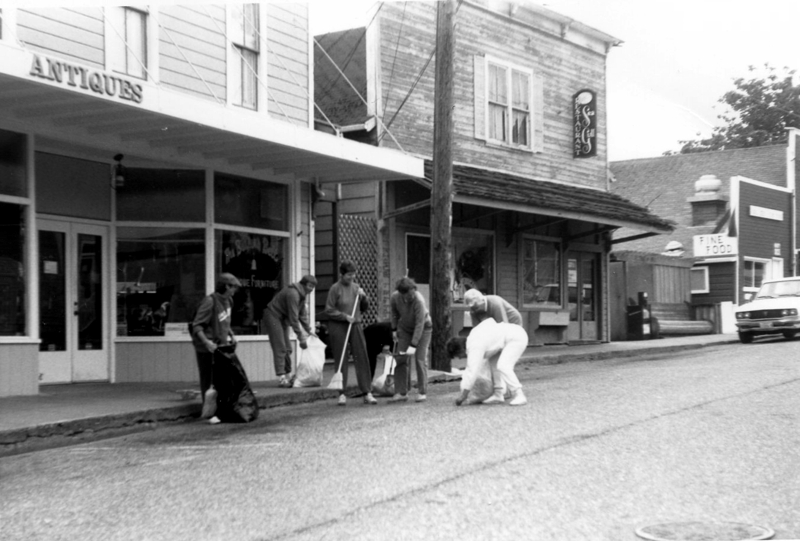
Butler's Bell Antiques on the left during a 1980s cleanup after a festival.
Courtesy: Island County Historical Museum, Coupeville
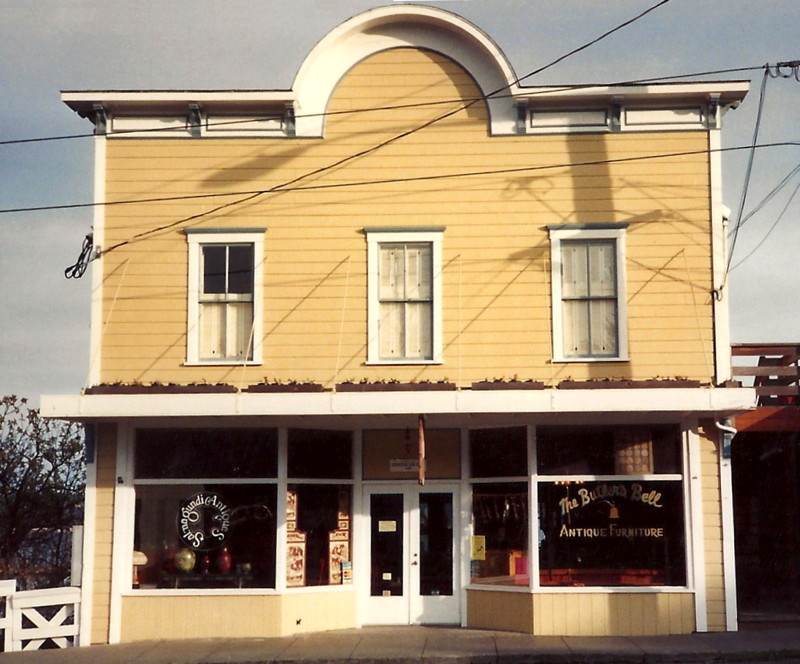
Salmagundi Antiques Store and Butler's Bell
Courtesy: Island County Historical Museum, Coupeville
1991 - Opened Great Times coffee shop with Seattle Best Coffee downstairs until 2008.
1992- Skipper & Crew Gift Gallery 10/92 sign permit - DeWayne & Joann Hess
1996 - Purchased by Millie Fonda and John Collins of Stan and Ollie Inc. Jim and Lucille operated the coffee shop.
*Interview by Judy Lynn with Millie Fonda, 2008:
Judy: Where did you come from before moving to Whidbey Island?
Millie: I was in transition from upstate New York returning to Washington, my home state. I grew up in Whatcom County and wanted to get back to my roots. I passed through Coupeville with my partner John Collins. We loved the area and we talked about buying something as a project. We were not thinking of buying a project as big as the Coupeville Cash Store. We were interested in a small house to renovate. We were interested in the Captain Kinney house. The Coupeville Cash Store building was offered at a much inflated price by Dr. Kroll but we decided to look at it as a lark. When I saw the upstairs flat I said "I could live here" and we made an offer in the summer of 1996. That fall we moved here. We started the antique store to fill space. The only business in the building at that time was the coffee shop. The owners, Jim and Lucille, lived on Parker Road.
Julie and George Lloyd took over coffee shop from Dr. Ken Kroll. Dr. Kroll owned the building, according to the 1995 prospectus, for 22 years. It had been vacant for a year. That would mean he bought it in 1972. The upgrades he made were the wine cellar and tasting room in basement, excavating under the wall, and laying oak plank floors from 1974 over an 8 year period. He put on a new roof, and replaced wiring and plumbing, as well an apartment update. Bill Skubi worked on the basement renovations as the first of his jobs as an electrician.
George's antique business was in this building and Julie ran the coffee shop. I think Dr. Kroll and George may have been in the antique business together. It was called the Butler's Bell.
Judy: How did you decide to open an antique store?
Millie: John was wonderful craftsmen and artist and had a collection of Edison gramophones. We both loved antiques. I had a bed and breakfast and I brought a lot of things from New York. The Antique Mall started because we needed people to partner with us. I had lived for short time on the east side - Issaquah and Renton. John and I lived in the same neighborhood in the late 1960's and had partnered in a place in a mall. The couple that owned that mall helped with our business plan for Penn Cove Antique Mall business.
Judy: How did you come up with the name?
Millie: It was Penn Cove Antique Mall and it was a mall from the beginning.
Judy: How did you find partners?
Millie: We put a big sign in the window. We thought it would take forever but in was no time at all before people came. One of our first customers was Chris Pawley who lived in Mary Fullington's house after Mary died. She had had a business in Pioneer Square—an import store featuring antiquity of other countries. She had a space in the mall.
Ted and Lyla Shamack lived on Sherman Road below the cemetery. They were from Denver. She had owned a shop there and they had a nice collection of things. Linda Sharp, who owned the "Kon Tiki" house had glass. And Jeff and Karen Ambrose. Karen is now a part owner of Antiques in Greenbank. We ran it for eight years. We partnered with Carrie McGraw and then she opened the Stray Dog Company. She had half the building and the Mall had the other side in 2004 to 2005. John was sick and we couldn't do it anymore.
In 2003 we felt the need to retire because John was diagnosed with cancer. We invited Carrie McGraw who owned the Stray Dog Company. She sold at an antique mall in Snhohomish. She moved the Stray Dog to Coupeville in what was the Penn Cove Restaurant building on Coveland. She wanted more traffic. I wanted to share the space and work schedule. We shared those responsibilities. As John's cancer progressed we turned over the street space to her. John Collins died of cancer November 3, 2005.
In 2005 we transferred the whole building to Carrie and she was running both businesses. She tried to sell the business but didn't find a buyer. Up to that point we took turns - a week at a time. She went out of business in 2006.
When we bought the building we formed a corporation named Stan and Ollie Inc. That was to keep our financial investments separate.
Judy: How did you arrive at that name?
Millie: We had to have a name but all combinations of our initials were all taken. John was quiet and reserved and I was outgoing. John used to say, "A fine mess you've got me in now Ollie". "Stan and Ollie" was available.
We sometimes we called each other Pet and Bunny. The first owners of the building, Albert Kennith, called his wife Lizzie, Pet, or PK. Lizzie called her husband, Albert, Bunny. At one point we rented our studio apartment as a summer rental and we called it Pet and Bunny's. According to Jimmy Jean Cook's book (A Particular Friend, Penn's Cove) Lizzie always played the piano for dances. When we were thinking of buying this building we paid homage to Pet and Bunny by taking them flowers to the cemetery.
Judy: Was the space upstairs on the street side an apartment when you bought the building?
Millie: It was empty. I think the county rented it as office space. They put in office lighting that is still there. Carole Lee and Woody Hershman rented it for their Hoyt Holster business to house out of town people. Their main client was the Los Angeles police department. The Hersman's were our first tenants and they leased for one year. Next was the manager for Best Western in Oak Harbor, Desmon Mollander. He leased the apartment for four years. Later he managed the Edmond Meaney Hotel that became a Best Western in U District in Seattle. He lives in Hawaii now.
Then we rented it as a short-term rental as Pet and Bunny's and for our own guests. Then Patty Styles had it for her massage business for a year. Sue Blouin lived there right out of high school. Nancy Brown has been there for a year.
A couple came in to tell us they met in the apartments here and got married. He was career military and lived in the water side of the building and she was a school teacher and rented the front on the street side.
When we bought the building the street level and both apartments were empty. Downstairs was the Great Times Espresso coffee shop, run by Jim and Lucille. They sold the business to Kathy and Al Griggs. When Dr. Kroll owned the building there was a ribbon cutting to open the first Seattle Best's Coffee shop. He named it Great Times. The Stuart Brothers started their coffee roasting business in the Ice Cream shop (Island County Abstract Office) across the street and had already relocated their business in Seattle. They came back to open the coffee shop here. George Lloyd has a photograph of the ribbon cutting.
Later, Al and Kathy Griggs thought the coffee was too expensive so they changed to a different brand. They later expanded to pizza and food. Seattle Best's Coffee sold to Starbucks but there are a few coffee shops left.
The Griggs' had the coffee shop for maybe five years and then they sold to Stacy Crandel (Lyla Snover's niece) but kept the Great Times name. Her daughters ran the shop as a family business. Kim Noel and Shelby Eckroth bought the business from Stacy. They changed the name to the Coupeville Coffee House. The "curse" was then upon it. They were the last people. They closed it in the winter of 2008. It's now empty and I'm beginning to renovate. I plan to remove the soaking tub and steam shower that Dr. Kroll installed during the wine cellar days. They don't belong in a commercial space.
The business on the main floor went from the Stray Dog to Debbie Crocker's, Back to the Island. It's her 2nd business on Front Street and is the current occupant.
About this building, I heard that during the war in the 1940's the Navy used half of it for Navy housing because there wasn't enough housing in Oak Harbor. The other half was the pharmacy and ice cream shop. The Coupeville Cash Store was the biggest department store on the island.
Gordon Gookinss used to come in and tell stories about Coupeville. His father was the sheriff but was jailed after being caught bootlegging. He was the bartender at the Central Hotel. Gordon told me he would look up the stairs on the mezzanine and covet a toy truck that was on display. He said in all the years since when he would walk into this building he would remember looking up to see the toy truck. His family could not afford to buy the truck. He said that if he had gotten it he probably wouldn't remember it.
People would throw garbage out the back of these buildings on Front Street and there were privies at the end of each building that dumped into Penn Cove. There is still one in Karl King's building (Benson's Confectionery) next door. You can look up from the beach and see the hole. Gordon Gookinss said he and his friend found what they thought was Chicklets gum on the beach and they chewed several packages. It was X-Lax and they were so sick.
Ethel Lee Maylor would come in and tell stories and she could always draw a crowd. "If you don't know the truth make it interesting" a friend said. And she always did. John called her Kondike Annie as she had lived in Alaska for a time. She was in Louise Mueller's adult family home at the end of her life.
The Skipper and Crew, owned by Joanne and Duane Hess, was once in this building.
A previous use of the building was as a buggy shop in 1889. There was a ramp that led up along the side and I have photos of barn doors where the coffee shop is. There are still tie-up rings embedded in rocks in beach.
Two years after we bought the building we put in new windows on the waterside to bring in more light. Terry did the renovation.
During the water festival they used to hang bleachers on the waterside of the building for people to sit and watch the canoe races. I have a photo showing the building before the windows were put in downstairs.
In a photo of with "L.N. SILL S GROCERY 1925" you can still see the mezzanine. There is fresh produce and what looks like fly strips hanging down. It was called L.N. SILL General Merchandise.
Judy: What about the attic space?
Millie: The two apartments were accessed by outside stairs. We occupied the front apartment (water side) and we knew there was an attic space viewable through a crawl space. The building had a mezzanine with stairs that led up at the back of store. When they put in the apartment during the 1970s this was blocked off. The room was the original office for the building and they could see the ships coming in. They displayed merchandize on the mezzanine. There was a window on the upper level, the 4th level. We knew there was a space upstairs because we could see the window from the wharf. When we thought about retiring and making a space for John (his hobby was making models) we made a space with a drop down attic ladder and now's it's a usable space. There had been a fire in the 1970's, before Kroll, and we found the original wallpaper. We saved as much of the wallpaper as we could. We have a collage with wallpaper attached to muslin or bunting cloth, probably some of the papers they sold in the cash store. There is an "A" attached to fabric and "Oriental Bunting" advertising which must be like a wall covering with a drawing of three women who are not Asian.
In the attic now is a finished room for John's model making with tool workbench and a craft area for me. We added the wainscoting. Behind that wall a door opens into the attic structure that goes to the back wall of the front apartment. There is a firebreak. It is open with floor joists and insulation.
We bought some of the original store cabinets and display cases that were in this building from the estate of Walt Sewell (whose house was across from the Masonic Hall) and returned them to the building. (Alvah Blowers owned the Sewell House.) Peggy Sewell had an antique store in the small house next door to their home. There is a huge safe in the basement that says "Kineth and Blowers."
Judy: Warner Brothers produced Practical Magic here on Front Street. What was that like?
Millie: We had a great time. I have a drawing by the set designer of the movie of the front of this building. There was several months of negotiating with local businesses before they started. In April 1998 they painted the whole street white and redesigned it as a New England town. We chose our colors and they had the buildings painted again. Our business, Penn Cove Antiques, would rent things to them and they would buy things from us and would return them but wouldn't take the money back. We were on a first name basis. When it was over we had a big party on the deck for everyone who was involved with it. I have lots of pictures. The movie stared Sandra Bullock, Nicole Kidman, Dianne Wiest, Stockard Channing and Aidan Quinn.
At the same time Universal was doing the movie, Snow Falling on Cedars, with Ethan Hawk at the Ebey Ferry House. We sold a lot of things for the inside of the house where they were filming.
Years later people still came back and asked, "Is this where they filmed Practical Magic"? It was well received in Japan and we had many Japanese visitors who came here to visit the spot where Practical Magic was made.
The designer created a gate between Captain's Galley and our building. Before that people would come off the street into our private space. They designed a gate I wanted. They put pillars from the overhang for the movie but had to remove them due to town ordnance. We were closed and they compensated us and it was a fair compensation. They didn't pay us for cost of goods but paid for our profit margin. Everyone was paid but we were paid more than average because they bought items from us. Sandra Bullock bought all kinds of great antiques from Quinn's Antiques [Howell's Barber Shop building].
We just had great fun with it and enjoyed seeing how a movie is being made. I was paid $50 per day for being an extra, for doing nothing. A lot of friends came from Seattle and watched from our building. The staging for extras was in the Captain's Galley (John Robertson's Store).
1995 - A re-roofing application was made by Ken Kroll to sell the building
1997 - Penn Cove Antique Mall application signed by John Collins.
1998 - Millie and John put in new windows on the waterside of the lower level to bring in more light.
2003 - Penn Cove Antiques and The Stray Dog [a pet store for dogs] run by Carrie McGraw, were in the building.
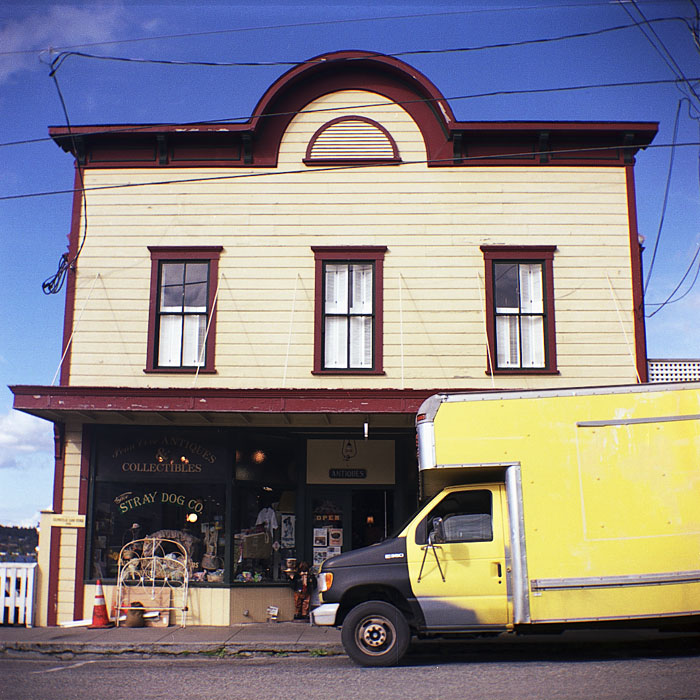
The Stray Dog
Courtesy: Courtesy: Gordon Coale blog http://www.electricedge.com
2003 - Fonda/Collins retired and Carrie McGraw ran both businesses.
2006 - Carrie McGraw closed both businesses. After Carrie McGraw both sides of the building were One More Thing
2009 - Millie Fonda had the basement space renovated, removing the soaking tub and steam shower, and leased the building to Rita and Chris Tomayko who opened the Mosquito Fleet, serving chili and other food and baked goods. It operated for three years.
2011 - Two new stores were Eagles Song Health Foods, and Far from Normal a gift store.
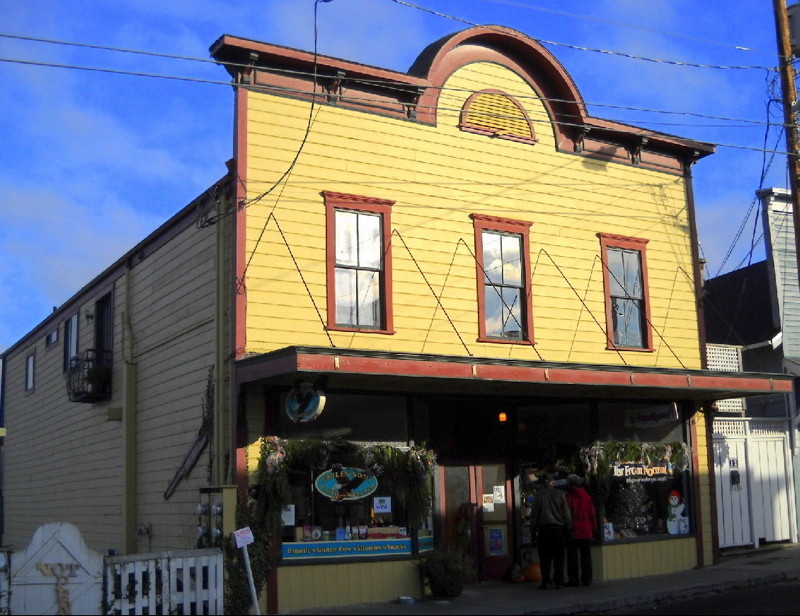
Eagles Song Health Foods, and Far from Normal
Courtesy: Rock n Roll Doctor at Panoramio
2012 - The Thai restaurant owner took over the downstairs.
End of 2013 - Eagles Song Health Foods closes.
2014 - Anchorage Real Estate opened by Colin Curtis in the west section of the building. The upper floor continues to be an apartment.
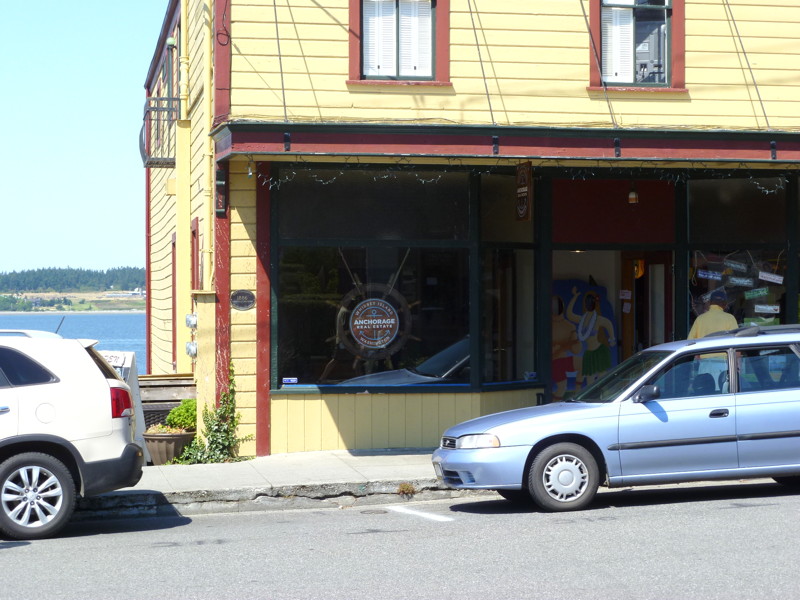
Anchorage Real Estate
Courtesy: Robert Y Elphick - 2014
2015, June - Anchorage Real Estate is replaced by Whidbey Isle Yarns selling tea and gifts in the west portion of the building. The upper floor continues to be an apartment.
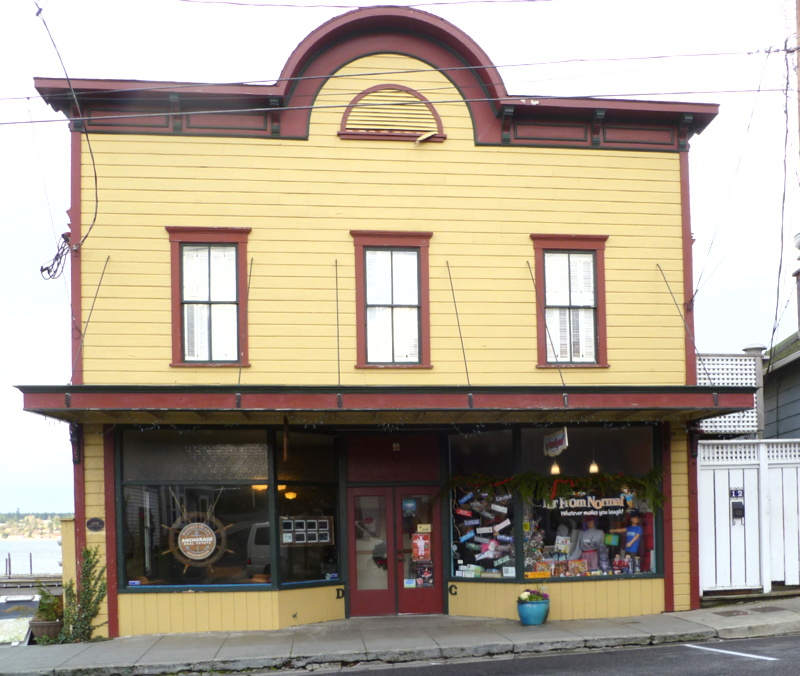
Anchorage Real Estate
Courtesy: Robert Y Elphick - 2015
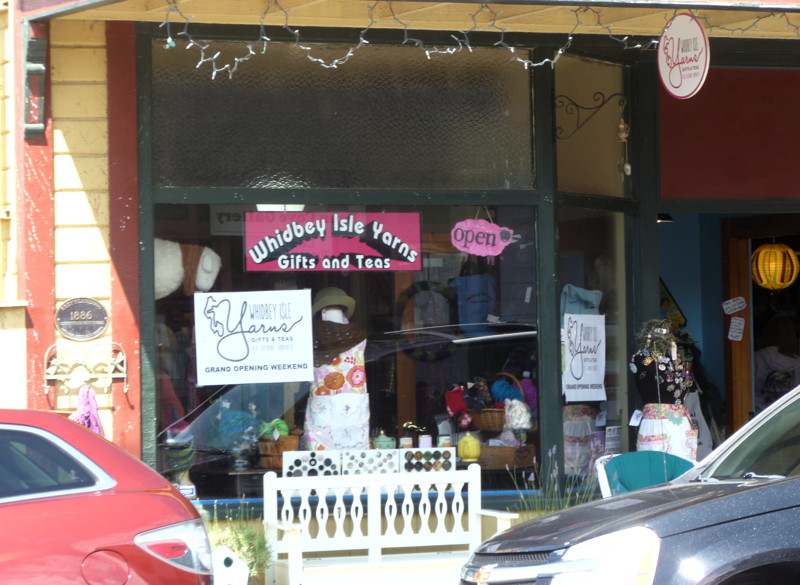
Whidbey Isle Yarns
Courtesy: Robert Y Elphick - 2015
Lower Loft Eatery is downstairs on the lower floor.
2019 - Sea Bre's Yarn Shop - Full array of knitting, crocheting and fiber art supplies. Hand dyed yarns, needles, patterns and more.
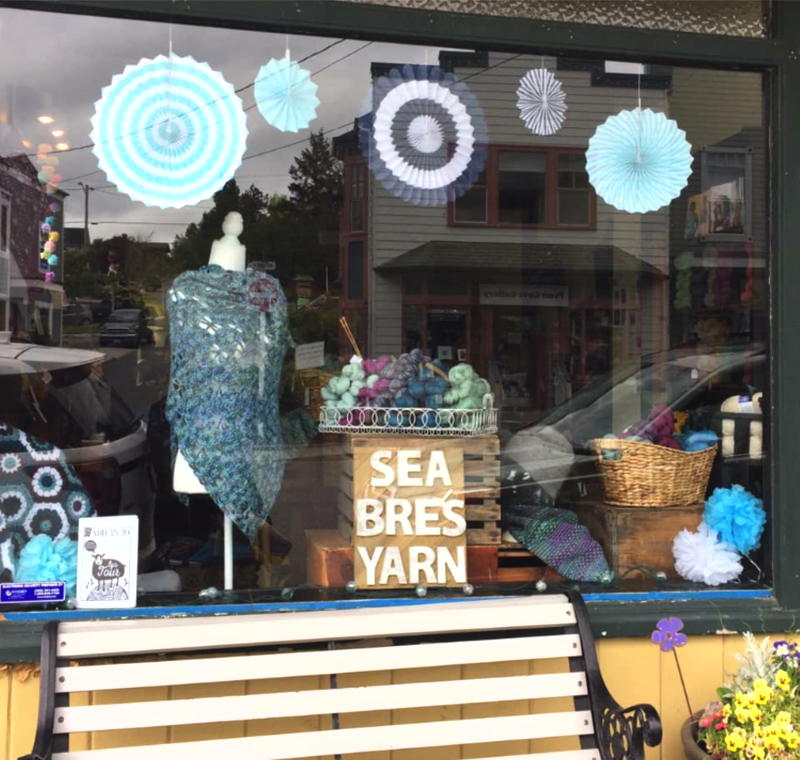
Sea Bre's Yarn Shop
Courtesy: Gwen Samelson - 2019
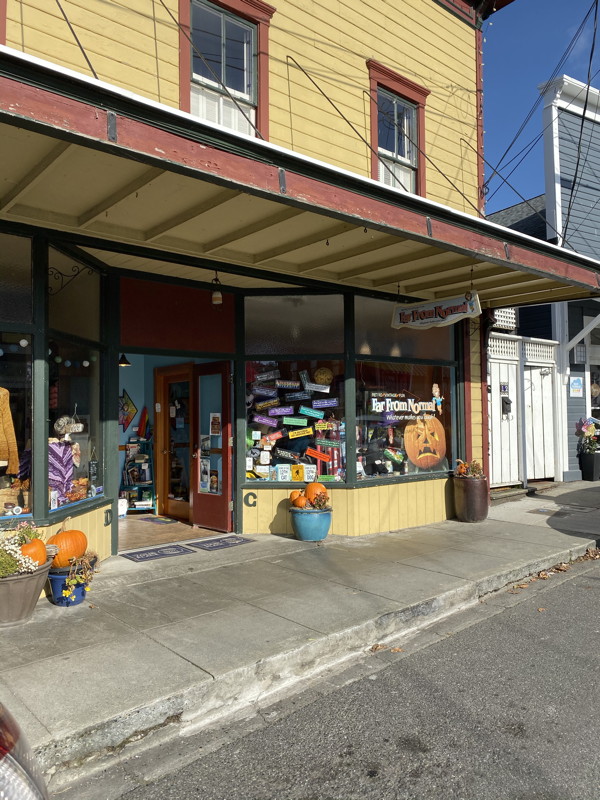
Far From Normal
Courtesy: Robert Y Elphick - 2019
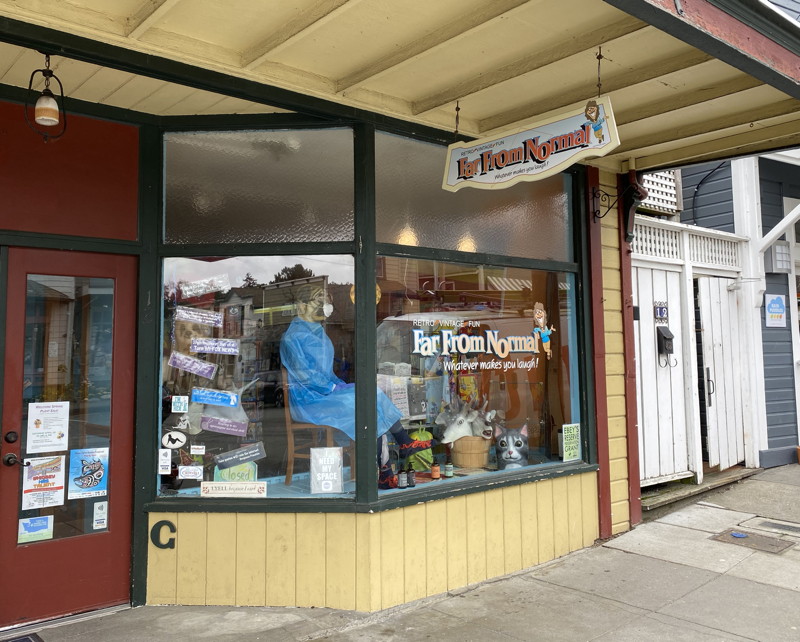
Far From Normal during Corvid-19 outbreak and shutdown
Courtesy: Robert Y Elphick - 2020
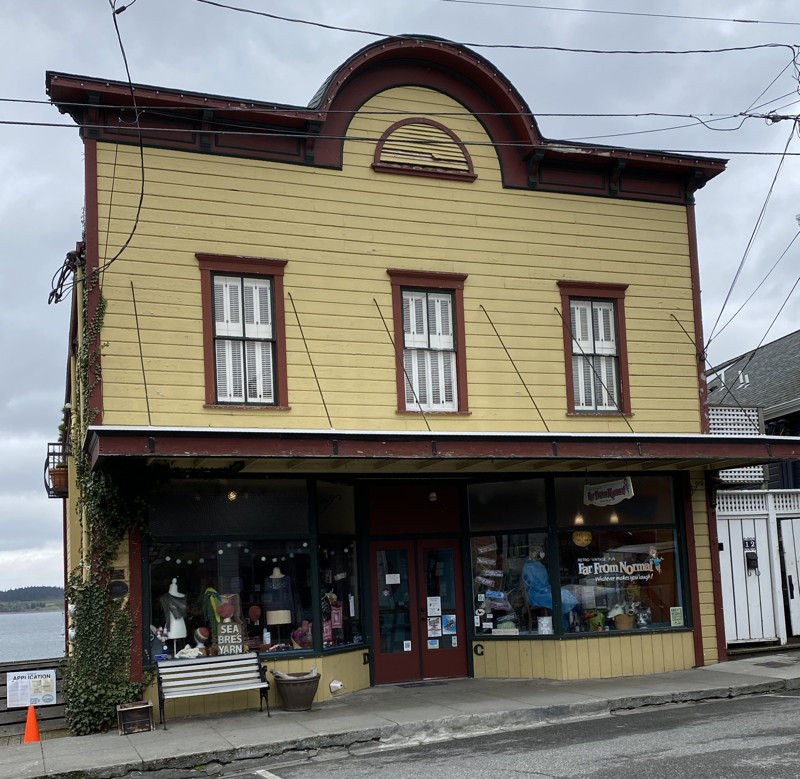
Blower's Building
Courtesy: Robert Y Elphick - 2020
2019 - Building sold
2020 - Far From Normal Closes.
2020 - Building under going top to bottom renovations through 2021. Sea Bre’s Yarn Shop is closed while renovations are underway and will return at the building's finish.
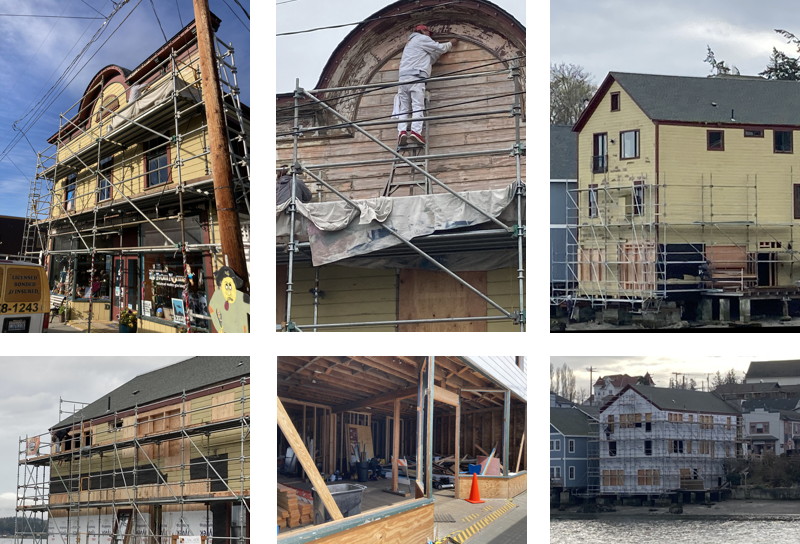
Blower's Building During renovation 2021/2021
Courtesy: Gwen Samelson
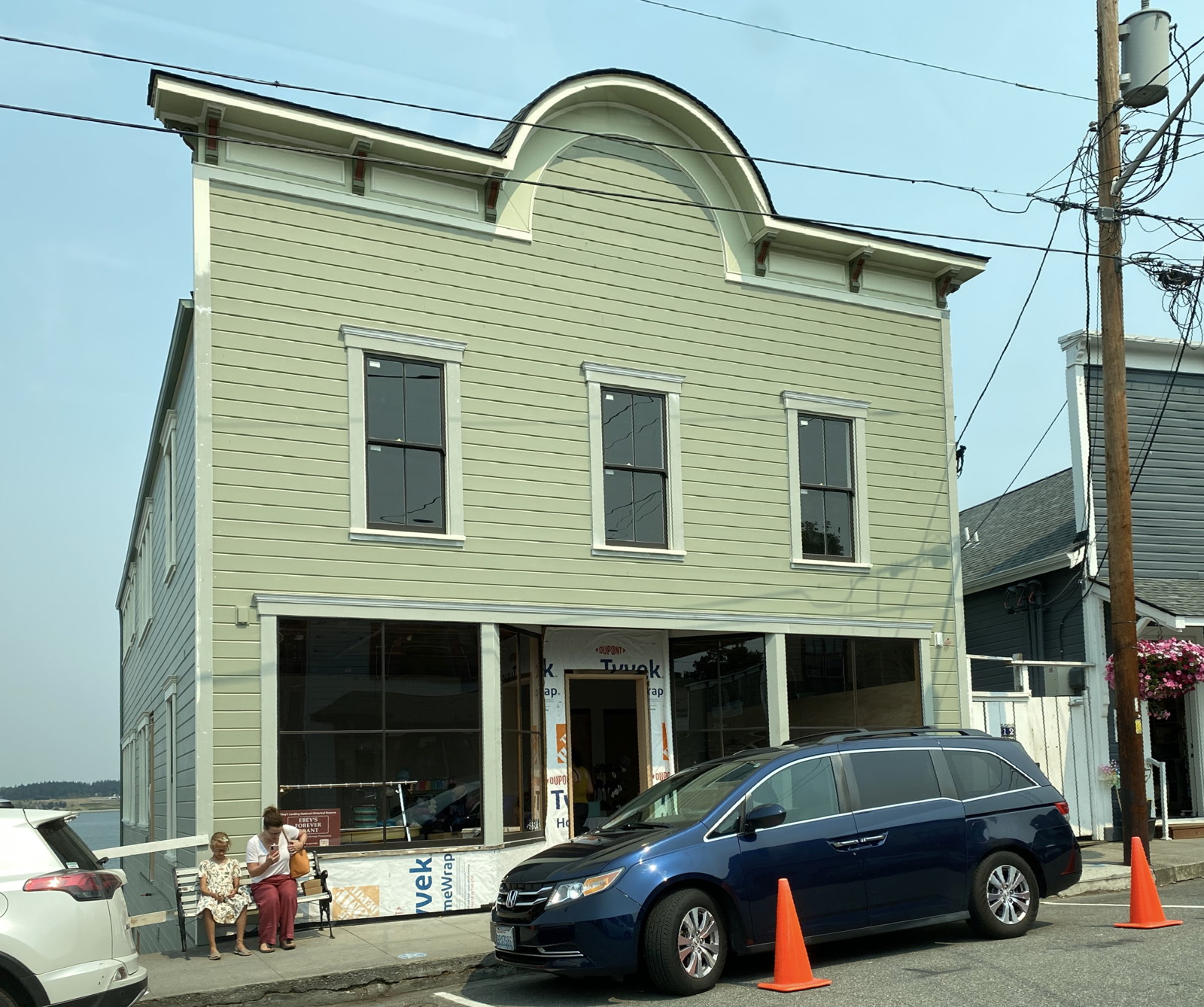
Blower's Building after external renovation 12 August 2021
Courtesy: Robert Elphick
2024 - Owners Von and Barbara Summers made significant renovations. Currently Sea Bre's Yarn shop. Rest of building has 3 short term rentals
2024? - Salty Vons Waterfront Inn opened.
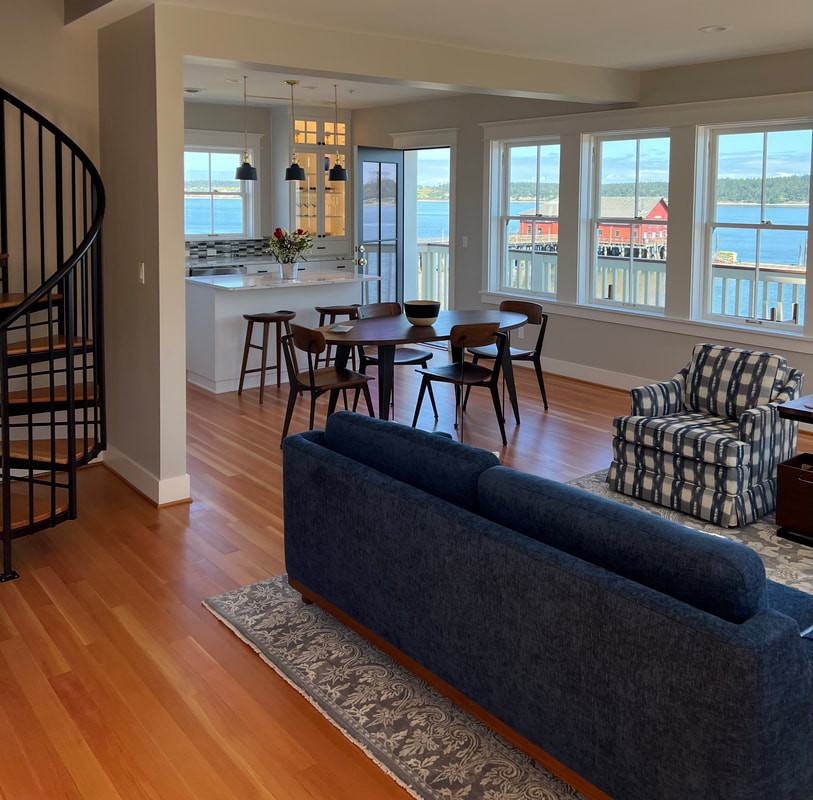
2024 - Inside Salty Vons Waterfront Inn. (from their website)
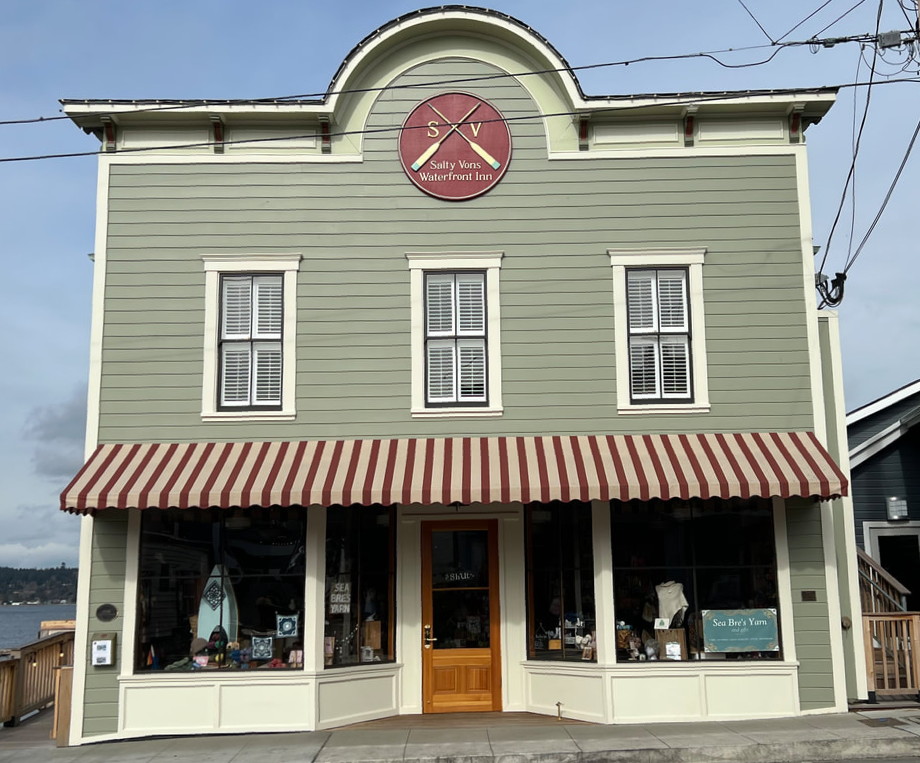
2024 - Blower's Building with Salty Vons Waterfront Inn upstairs.
(from their website)
* All the interviews are extracted from the Judy Lynn's Oral History Project. Judy Lynn interviewed everyone she could find who had any memories of the history of Front Street. For more information on the project contact the Whidbey Island Historical Musem, Coupeville.
The e-book Front Street, Coupeville - An Oral History by Judy Lynn contains all the interviews. It can be purchased for $9.99 at Amazon.com for Kindle application or device or from the Apple Store for iBooks applications. Proceeds go to the Island County Historical Society.


